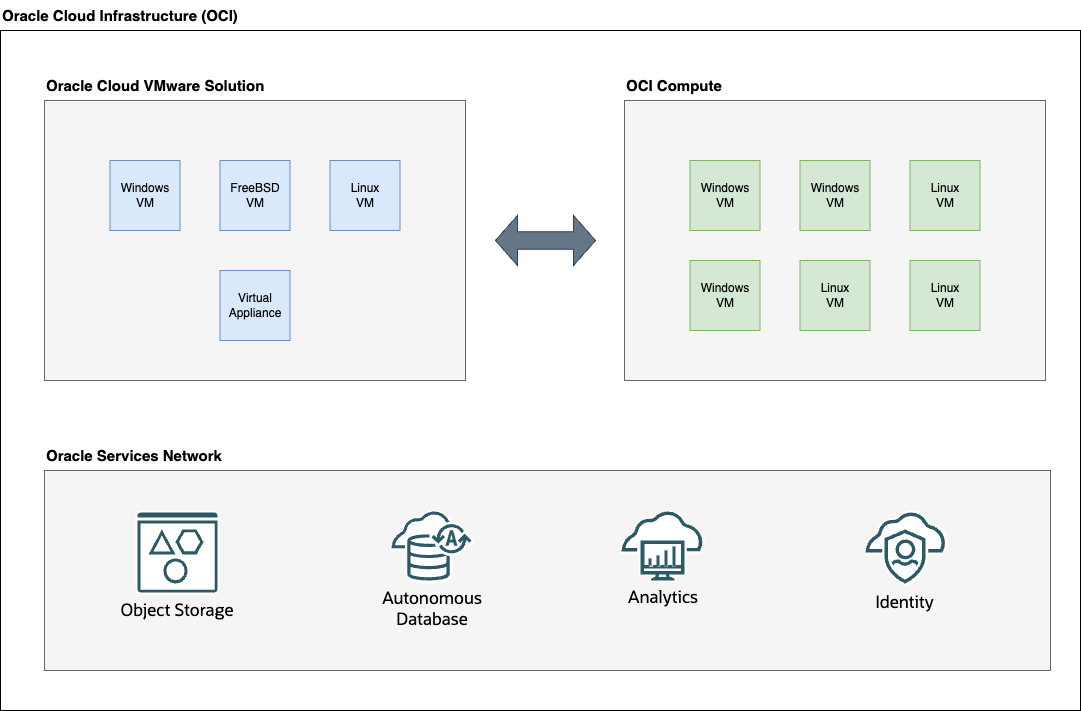In this blog post, we look at an alternative deployment architecture for Virtual Machine workloads in the cloud: A hybrid deployment that can help customers use the best of both Oracle Cloud VMware Solution and the Oracle Cloud Infrastructure (OCI) Compute service. This topic is on the minds of many customers who are looking for solutions to optimize their cloud architecture, operations, and costing.
To migrate or not to migrate
this is the big question, as many customer think cloud is always expensive but is that ture? For example you can build hybrid deployments for workloads that cannot run cost efficient on Oracle Cloud Infrastructure for example a large set of Windows Servers, for this type of workloads, OCVS is the ideal platform and in that case you could potentially host Linux VMs on OCI compute to make use of paay-as-you-go and integrated OS licesning. But as always there are a lot of challenges and thinks to consider.
When looking at a customer’s environments, you can quickly notice that workloads are diverse when it comes to factors like operating systems, applications, and licensing. A typical on-premises environment consists of multiple operating systems, versions, and applications, including the following examples:
- Microsoft Windows Server 2008R2, 2012R2, 2016, 2019
- Microsoft Windows 8, 10, 11
- Oracle Linux
- Red Hat Enterprise Linux
- SUSE Enterprise Linux
- Ubuntu
- FreeBSD
- Virtual appliances
With all these different operating systems and versions, building a detailed migration strategy makes sense. Migrating everything as is to Oracle Cloud VMware Solution is a valid solution, but in this scenario, the customer still ends up in an environment doesn’t not really benefit from all the benefits that OCI can offer, such as dynamic scaling, running virtual machines (VMs) on a pay-per-use model, integrated backup, and disaster recovery. This idea brings us to the topic of this blog post: Building a hybrid setup between Oracle Cloud VMware Solution and OCI Compute to optimize workloads, operating model, and overall cost.
How Oracle Cloud VMware Solution and OCI Compute can help

This simplified view shows a distribution of VMs across Oracle Cloud VMware Solution and OCI Compute, but this method of distribution isn’t very cost-effective. An effective solution includes keeping all Windows-based VMs on Oracle Cloud VMware Solution and hoting everything Linux-related or an OCI-supported operating system onto OCI Compute. Licensing for Windows operating systems on OCI Compute can get expensive, depending on the number of VMs.
A detailed cost comparison between Oracle Cloud VMware Solution and OCI Compute is always required. But a potential lower total cost of ownership (TCO) for Oracle Cloud VMware Solution compared to OCI Compute doesn’t necessarily mean that it’s the right target solution. You must calculate the Bring Your Own License (BYOL) for Guest Operating Systems, a VMware-supported backup solution, extended monitoring tools, and a complete operating model for hosting VMs on Oracle Cloud VMware Solution.
For a more licensing-optimized solution, identifying which operating system is supported on OCI Compute is key. You can find the list of supported operating systems in Choose your operating system.
When identified, you can design the solution to split up the VMs across Oracle Cloud VMware Solution and OCI Compute. In this example, we host Windows-based VMs, virtual appliances that don’t have an equivalent offering on the Oracle Cloud Marketplace and FreeBSD on Oracle Cloud VMware Solution, and all Linux-based operating systems like Oracle Linux, Red Hat Enterprise Linux, SUSE Enterprise Linux, and Ubuntu on OCI Compute.

This setup allows the Oracle Cloud VMware Solution environment to be very cost optimized. You save costs and operate legacy operating systems in the future, while the OCI-supported Linux VMs hosted on OCI Compute benefit from integrated licensing, backup monitoring, and so on.
Conclusion
Finding the right strategy isn’t always simple with the complexity of large environments. The decision impacts the overall sizing and costing of a cloud-based solution because it’s driven by factors like a quick data center exit, OS licensing, application licensing, cloud operations, and cost. Oracle Cloud VMware Solution offers the fastest way to migrate to the cloud by keeping your operating model and environment behavior, but it lacks the flexibility and integration that OCI Compute offers, such as pay-as-you-go, integrated backup and disaster recovery capabilities, monitoring, and OS management.
Considering all these factors, consider the following point when planning a migration to the cloud into a cost and operations optimized environment:
- Perform a proper assessment of the on-premises environment.
- Verify feature requirements.
- Verify application interdependencies.
- Verify migration method.
If you’re interested, contact our Oracle Cloud VMware Solution Specialists. We can provide you the level of support required to make your project a success. For more information, see the following resources:
